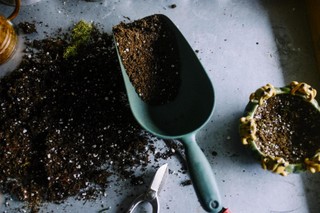What is perlite good for? Uses, types, and comparing growing media

Ever take a look at the potting soil in your container plants and think those little white specks are styrofoam? If so, you’re not alone. Although extremely similar in appearance (and “clinginess”) to styrofoam, those little white balls in your potting mix really aren’t styrofoam after all. They are actually little bits of expanded rock called perlite and have a very valuable place in gardening and horticulture.
How perlite is made?
A natural volcanic glass, perlite is typically made from the hydration of obsidian. The chemical made up is seventy to seventy-five percent silica or silicon dioxide; the remaining twenty to twenty-five percent is a mix of aluminum oxide (Al2O3), oxides of sodium, potassium, iron, magnesium, and calcium, and moisture.[1]
To create the perlite we are familiar with, the gray to black obsidian rock is mined, crushed into smaller fragments, and then heated to very high temperatures. Once temperatures reach 850-900 ℃ the perlite becomes soft. Water trapped inside the rock vaporizes and tries to escape, expanding the rock to more than 10 times its original volume and changing the color or perlite to white. An extremely similar process to making popcorn.
The resulting expanded perlite is a lightweight material full of tiny little air pockets; it is clean, sterile, and resists compaction. The pockets on the outside absorb water, blocking moisture from entering into the center of the perlite pieces.
 Close up of crushed perlite.
Close up of crushed perlite.
Uses for perlite
Yes, most of us are familiar with perlite because of its uses in gardening, but it actually plays important roles in other industries because of its lightweight nature and other advantageous properties.
- Gardening: Perlite can be added to soilless mixes to improve drainage and aeration, providing more oxygen to plant roots. It is also added to gardens as a soil additive to improve soil structure. Perlite also helps reduce soil compaction in clay soils. It is used as a standalone product to germinate seeds, root cuttings, and anchor/support root systems in hydroponic gardening setups. Epsoma is a great option for perlite and other gardening needs. Purchase it on Amazon here.
- Construction: Perlite is used as loose fill material in hollow concrete blocks or masonry walls for insulation.
- Filtration: Perlite is increasingly being used to filter solids out of liquids in many applications. It is used to filter beer before it’s bottled to remove sediment and is used to filter stormwater runoff from roads and highways.
- Manufacturing: Perlite is also used as an ingredient in lightweight concrete and plasters, ceiling tiles, and acoustical sprays to name a few.

The enthusiast's guide to herbs
We’re proud to present our new e-book, The Enthusiast’s Guide to Herbs! Learn everything you need to know about growing and caring for herbs indoors, including in-depth info cards for the 35 most commonly grown herbs.
Click the link below to find out more!
Types of perlite
After heating and expansion, horticultural perlite is separated into four different grades based upon the particle size: super coarse, coarse, medium, and fine grade.
- Super coarse perlite has particles ranging in size between ¼ and 3/32” with a water holding capacity of 19%. Creates the best porosity for drainage and aeration but isn’t as popular in gardening because of the particle size.
- Coarse perlite ranges in size between 3/16 and 3/64”, with a 34% water holding capacity. Considered an all-purpose grade it is a good balance of drainage and water holding capacity. Due to its size, it doesn’t blend well with garden soil but makes a great media for succulents and orchids.
- Medium grade perlite is a middle ground between the coarse and fine grades ranging in size between ⅛” and 1/32”. It has a 46% water holding capacity and is best to use alone as growing media for potted plants and potted seedlings or as an ingredient in potting mixes with other components.
- Fine grade perlite has the smallest particle size, with pieces between 1/16 and 1/128”. With a water holding capacity of 52%, it works well for rooting cuttings and starting seeds.
Pros and cons for gardening use
As with so many other products, perlite has both its advantages and disadvantages as a growing media. In this case, the advantages far outweigh the downfalls boosting its popularity in the horticulture industry.
Pros:
- Its sterile nature makes it highly suitable for starting seeds. There is little risk of root rot or damping off.[2]
- Naturally contains minerals needed for plant growth.
- A non-toxic substance that doesn’t require rinsing like some other growing media does prior to use.
- Neutral pH doesn’t need to be adjusted, nor will it adjust the overall pH when mixed with other components.
- It can be used alone or mixed with other media to create potting mixes.
- Great for seedling germination or plant propagation as the particles allow for plants to be pulled from the perlite without damage to the root systems when it’s time for transplanting.
- Reusable year after year since it doesn’t decompose.
- Low-cost option, perlite is cheaper than sand per cubic foot, costing about $4 or $5 per cubic foot.
- Easily available and simple to manufacture.
Cons:
- Water can drain away quickly. Perlite holds water in the nooks found on its large surface area but since it’s made of amorphous volcanic glass it doesn’t hold it tightly.
- Being so lightweight, perlite can be blown away and tends to float in excess water.
- Nonrenewable resource. Although more readily available than peat moss, it isn’t considered renewable like coconut coir.
- Dust can create respiratory problems and eye irritation. When working with perlite make sure to take precautions by wearing goggles and a mask to reduce dust exposure.
 Vermiculite vs Perlite
Vermiculite vs Perlite
Growing herbs in perlite
I’ve talked about how perlite is useful for starting seeds, and rooting propagated cuttings because of its sterile nature and ability to drain excess water quickly. All herbs can be started using perlite as the sole growing media. When it’s time to pot up plants into containers while some herbs will thrive growing in only perlite, some herbs prefer other types of growing media.
Herbs that prefer drier, sandy soils that drain quickly will grow well in perlite.
- Bay
- Chives
- Fennel
- Lavender
- Lemon balm
- Marjoram
- Rosemary
- Thyme
- Sage
- Oregano
Moisture-loving herbs such as basil, parsley, and coriander would grow better in a media other than perlite, one that holds onto more water.
Perlite vs other components
It’s commonly asked why perlite is so often used in gardening and if it is possible to replace perlite with other growing media products. The simple answer is that perlite is used often because of its low cost and extensive advantages. Also, there are common misconceptions about replacement products such as vermiculite or diatomaceous earth. These products are more complementary to perlite than useful as alternatives.
Vermiculite
When you look at a bag of commercial potting mix you quickly notice the little white specks of perlite and the little gold pieces that almost resemble teeny tiny blocks consisting of plates or layers of material. These gold pieces are vermiculite, another very important product in gardening. Gardeners often think the two are interchangeable but that isn’t the case.
Vermiculite also comes from rock, and expands like perlite, but has a higher expanding potential. When heated it expands into an accordion-like shape composed of many, many layers of thin plates. It has a pH close to 7.0 but it fosters alkaline reactions because of carbonate compounds, so it has the tendency to slightly raise the pH in the root zone.
The biggest difference between the two products is that perlite helps increase the drainage, while vermiculite increases water retention by absorbing water in its plate-like structure. Use perlite when you are growing plants that benefit from the growing media drying out completely between waterings (succulents, orchids); use vermiculite when you are growing plants that prefer to be kept moist such as tropical plants.
In essence, perlite and vermiculite act as complements to one another versus alternatives.
Diatomaceous earth
Diatomaceous earth, or DE, is a naturally occurring, soft, siliceous sedimentary rock. It is another additive gardeners keep in their arsenal but it shouldn’t be used as a replacement for perlite for a few reasons.
- Like vermiculite, DE is more moisture-retentive than perlite so it helps to keep water in the root zone versus increasing drainage.
- Diatomaceous earth typically comes in powder form versus a granular. When mixed into garden soil as an amendment it doesn’t have the ability to reduce soil compaction like perlite does.
- When wet, DE has the tendency to clump together filling pore space. This doesn’t encourage or allow good airflow and oxygen movement to the plant roots.
Conclusion
Perlite is a valuable product in gardening and commercial horticulture. Expanded perlite is extremely lightweight and porous increasing the drainage capacity and allowing improved aeration in the root system when it is utilized. It can be used as a standalone growing media for starting seeds, rooting cuttings, or in hydroponic systems; it can be mixed with other ingredients to create soilless potting mixes; it can be used as a soil amendment in the garden.

Join our email club—get printable info cards free!
Sign up to receive our newsletter and get access to 10 printable plant info cards from our e-book for free. Also receive:
- $4 discount code for our Guide to Herbs e-book
- Semi-weekly plant inspiration & bite-size tips and tricks
Samar, M., & Saxena, D.S. (2016). Study of chemical and physical properties of perlite and its application in India. International Journal Of Science Technology & Management, 5(4), 70-80. Retrieved from http://ijstm.com/images/short_pdf/1460020555_434V.pdf ↩︎
Horst, R. K. (2013). Damping-Off. In Westcott’s Plant Disease Handbook. Dordrecht, Netherlands: Springer. doi:10.1007/978-94-007-2141-8_25 ↩︎
